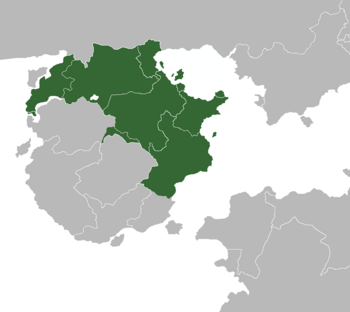Northern Confederation
This article is a work-in-progress because it is incomplete and pending further input from an author. Note: The contents of this article are not considered canonical and may be inaccurate. Please comment on this article's talk page to share your input, comments and questions. |
Northern Confederation | |
|---|---|
| 1660–2009 | |
 The Northern Confederation in 2000 with modern borders | |
| Status | Dissolved |
| Capital | Rotating; typically Kaigwa or Tepetlcali |
| Recognised national languages | Algosh, Housatonish |
| Religion | M'acunism |
| Government | Initially tribal confederation; later constitutional confederacy |
| History | |
• Great confederation | 1660 |
| 2009 | |
The Northern Confederation, officially the Confederation of the Universal North, was a country in Cusinaut. The Confederation, founded in the 17th century, united the dozens of different peoples of eastern Cusinaut into a loose confederation able to solve disputes between its members and establish firm rules for trading, and in so doing the new Confederation created nearly three centuries of stability and growth in Cusinaut. Critically, the Confederation also unified the military capabilities of its members, allowing it to consistently defeat efforts by the Occident to colonize Cusinaut, and even when Occidental colonies were established the strong defense of the Confederation prevented further expansion. The Confederation gradually become unable to resolve disputes, especially those involving the emergent Algosh and Housatonish ethno-linguistic groups, which led to the decline of its political relevancy. The Confederation continued on through the War of the Northern Confederation, wherein some of its members invited Urcean intervention against other members. Despite having been rendered functionally obsolete, the Confederation continued on through the war until the Algosh coup formally reorganized it.
The Confederation had many different forms over its existence, but the form it took by 1920 remained recognizable abroad and reflects its traditional core membership. Its 1920 borders now include the nations of New Harren, the Algosh Republic, the Chenango Confederacy, the Unnuaq Mission State, Housatonic, Pachaug, Ashkenang, and Maloka.
Etymology
In all applicable languages spoken in the Confederation, and usually in Algosh or Housatonish, the name of the state was the "Confederation of the Universal North". The "Universal North" referred not to a specific relative position on Cusinaut but rather both a perceived astronomical position on earth combined with a mystical directional belief related to the practice of M'acunism. Occidental lack of understanding of the tenets of the religion, combined with a desire for simplicity, usually means the state is rendered simply as the "Northern Confederation" in Julian Ænglish and other Occidental languages.
Geography
The Northern Confederation's boundaries varied over the course of its history. In the most consistent 20th century borders of the Confederation, it occupied a position in Cusinaut extending roughly from its northwesternmost point running southeasterly to the Nysdra Sea in modern New Harren. Accordingly, the Confederation in this configuration occupied about half of Cusinaut. Its position in the 20th century, and throughout most of its history, was oriented toward the Nysdra Sea and for much of its history it ran up the entire eastern seaboard of Cusinaut. Due to the breadth of the Confederation, it varied in climate and topography, though much of its territory sat on a plateau-like relatively flat elevation above sea level. The majority of the Confederation's territory featured a subarctic climate with tundra in the northern extremes and an oceanic climate in the southern extreme.
